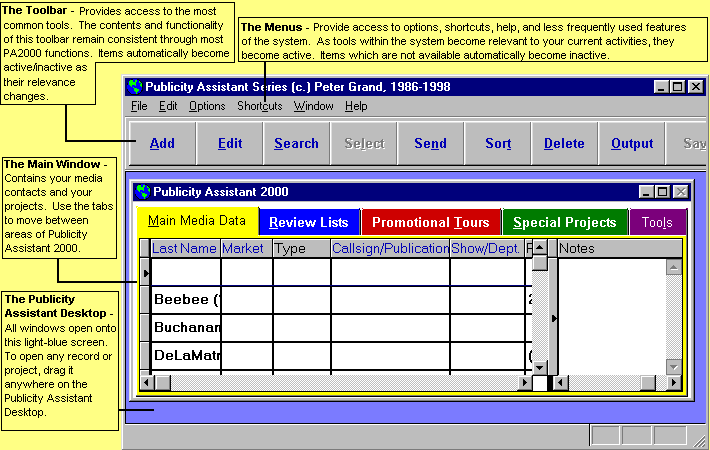Publishing Version |
High Level OverviewPublicity Assistant 2000 This latest version of Publicity Assistant provides a powerful contact management system, carefully integrated into a versatile and easy to use publicity management tool. Together, the tools of Publicity Assistant 2000 will greatly improve the efficiency and accuracy of managing your publicity needs. Publicity Assistant 2000 contains 5 main tabs; Main Media Data, Review List, Promotional Tour, Special Projects, and Tools. These tabs represent the 5 working areas of the system. The heart of Publicity Assistant 2000 is the Main Media Data. This area contains detailed information about all of your media contacts. All other areas of Publicity Assistant 2000 use this information to assist you in your publicity efforts. You can use your Main Media Data directly, or you can create publicity project files tailored for specific purposes. For a given publicity campaign, you will use the powerful search capabilities of the system to find the best, most relevant contacts. The first kind of project file you can create is the Review List. Here you can store targeted review lists, as well as requests for review copies, and catalog checklist returns. You can identify which of these contacts are to receive galleys, press releases, or copies of a finished book. The Review List project also allows you to track when books or releases were sent. You can even log reviews and examine any reviewer's track record. The second kind of project file is the Promotional Tour. Tours are designed to help you manage media campaigns in targeted markets. You can identify appropriate contacts, book engagements, fully annotate all scheduling details and print callsheets, itineraries, confirmation letters, etc. Finally, Special Projects are general-purpose lists often used for personal address books, party invitation lists, or catalogue mailing lists. We welcome your suggestions for custom special project features. The last page, Tools, is used for general housekeeping task such maintaining your market and category codes, setting up catalog checklists, duplicate checking and user settings. In addition, an intuitive and consistent toolbar stays atop your screen for most tasks, greatly simplifying your work. If you are familiar with the common techniques of Windows ™ 95 and 98, such as using the mouse, minimizing and maximizing windows, and dragging and dropping, you are well on your way to becoming a proficient user of Publicity Assistant 2000. The following figure outlines the key elements of Publicity Assistant 2000. This is the main screen you will see when you start Publicity Assistant 2000: The Publicity Assistant 2000 interface is simple and easy to use. You will
notice that it consists of menus, a toolbar, and a set of tabs. When you first start Publicity Assistant 2000, after
seeing the opening graphic, the main screen will appear, as shown above. This
screen automatically selects the Main Media Data tab. This Main Window provides the foundation for most of your Publicity
Assistant 2000 work. To continue with your introduction to Publicity Assistant
2000, select Main Media Contact Database. For an overview of the functionality of specific areas of Publicity
Assistant 2000, select one of the following topics:
What is a Review List
What is a Promotional Tour
Overview of Special Projects
Tools Overview
If you are new to Windows, you may wish to review the Windows help documents.
To do this, press the start button on your toolbar, and select Help.
The Publicity Assistant 2000 interface is simple and easy to use. You will
notice that it consists of menus, a toolbar, and a set of tabs. When you first start Publicity Assistant 2000, after
seeing the opening graphic, the main screen will appear, as shown above. This
screen automatically selects the Main Media Data tab. This Main Window provides the foundation for most of your Publicity
Assistant 2000 work. To continue with your introduction to Publicity Assistant
2000, select Main Media Contact Database. For an overview of the functionality of specific areas of Publicity
Assistant 2000, select one of the following topics:
What is a Review List
What is a Promotional Tour
Overview of Special Projects
Tools Overview
If you are new to Windows, you may wish to review the Windows help documents.
To do this, press the start button on your toolbar, and select Help.
|